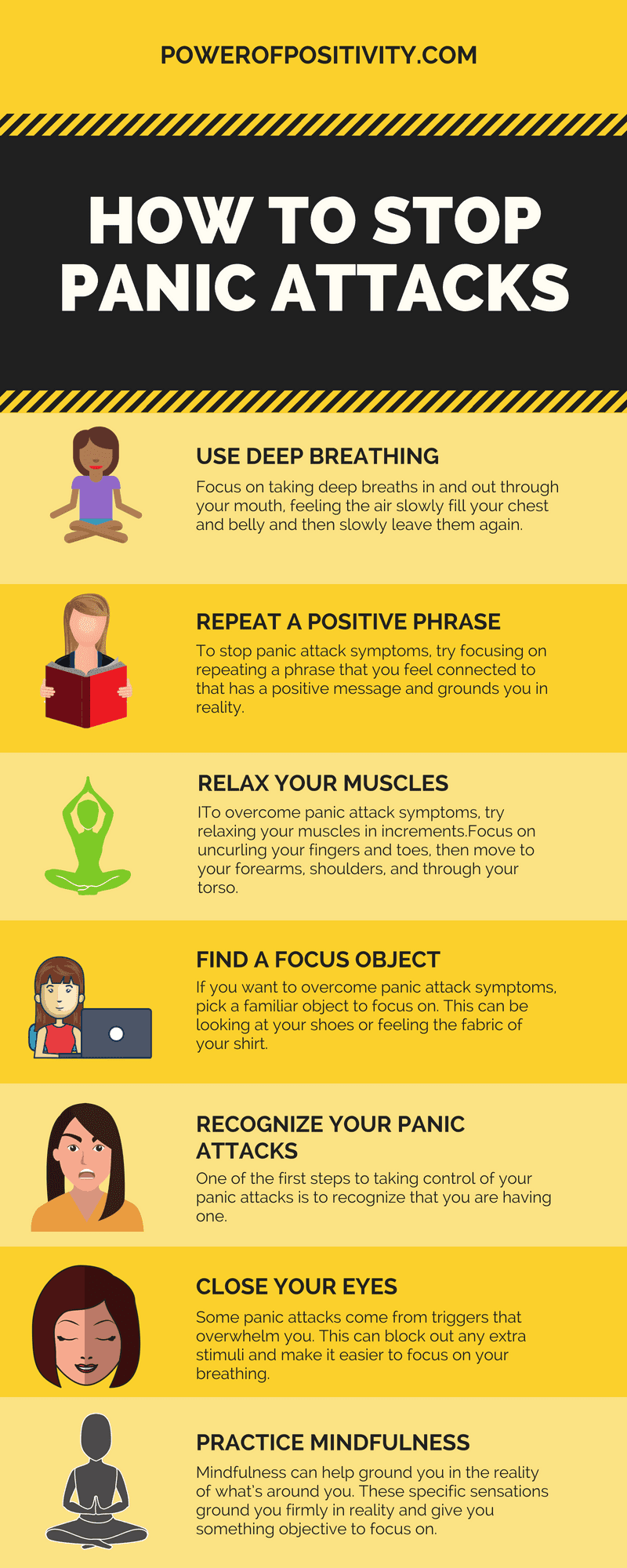Panic attacks are more common than you might think. They quickly overwhelm you. Besides those racing thoughts, people also often have physical symptoms such as a racing heart, sweating, and nausea. These incidents can come on out of nowhere, and leave you feeling downright helpless. To make matters worse, they are also often accompanied by severe anxiety and depression. You’ll be relieved to know that you can use mindfulness to stop panic attacks in their tracks.
It’s not uncommon for people who are suffering from these types of attacks to feel like they are alone, but if you are prone to panic them, know that millions of people just like you find ways to overcome them. There are many mindfulness techniques that you can use to overcome a panic attack and lessen its hold on you in the future.
5 Effective Techniques to Help You Stop Panic Attacks
Here are five mindfulness techniques that can help you overcome the symptoms of a panic attack, putting you on the road to recovery:
 1. Recognize Your Panic Attacks
1. Recognize Your Panic Attacks
One of the first steps to taking control of your panic attacks is to recognize that you are having one. It’s common for people who are having a panic attack to feel like they are having a heart attack or a stroke. But to overcome your panic attacks, you must first recognize when you are having one. If it’s your first time, you should see a doctor immediately to rule out other, life-threatening possibilities. But if you have experienced these before and know that you are otherwise healthy, remember that panic attacks come and go. Life will not be this way forever, even if in the moment you don’t feel well.
Mayo Clinic reports these common early signs of a panic attack:
- Elevated heart rate
- Hyperventilating (rapid breathing)
- Perspiring
- Shaky or trembling hands
- Interrupted sleep
- Unexplained feelings of tension or nervousness
- A sense of worrying
- Avoiding dealing with issues.
2. Practice Breathing Techniques to Stop Panic Attacks
Many people have difficulty breathing when they are having a panic attack. To lessen these symptoms, try to focus on breathing deeply. The oxygen that you receive through deep breathing will help you feel better, lessening symptoms like a racing heart and nausea. This technique also gives you something to focus on, lessening your feelings of helplessness.
After many years of debate, a 2021 study emerged. Researchers concluded that using “respiratory-focused interventions,” significantly improved symptoms related to anxiety.
3. Find a Focus Object
If you want to overcome panic attack symptoms, pick a familiar object to focus on. Mindfulness coaches refer to this method as object-focused meditation or concentration meditation.
This can be looking at your shoes or feeling the fabric of your shirt. Think about all of the details of the object. The texture of the fabric in your hand or the grain on a piece of wood could be your focus object. Think of all of the ways that you could describe this object. Also, if you are in a noisy or crowded space, try to find somewhere it is quieter so that you can focus more effectively.
4. Repeat a Positive Phrase or Mantra
To stop panic attack symptoms, try focusing on repeating a phrase that you feel connected to that has a positive message and grounds you in reality. For instance, you could tell yourself, “This is not forever, and I have a full and happy life to live.”
Choose whatever mantra makes you feel connected to the here and now but also reminds you that the way that you are feeling will pass and that you should not give up hope for a better life that is free of anxiety and depression.
5. Relax Your Muscles
To overcome panic attack symptoms, try relaxing your muscles in increments. Similar to breathing exercises, muscle relaxation meditation is another way psychiatrists suggest trying to the stop panic attacks. Because it helps you focus on one thing, this intervention will help alleviate the symptoms themselves.
Here’s why this activity works. People who are experiencing a panic attack will often clench their muscles, causing even more pain and discomfort. Focus on uncurling your fingers and toes, then move to your forearms, shoulders, and through your torso.
This could also reduce your feelings of nausea if those sensations are triggered by the clenching of your stomach muscles.

Final Thoughts on Knowing How to Use Meditation to Stop Panic Attacks
If you’ve ever suffered a panic attack, then you know how frightening and alone a person can feel when they are having one. If you or a loved one experiences them, there are things that you or your friend or family member can do to overcome them and lessen its hold on you in the present and in the future. Finding the right combination of mindfulness techniques that works for you or the loved one is key. The next time that you or a loved one needs to stop a panic attack immediately, try one technique at a time.

















